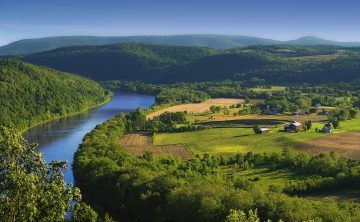by Carol A Westbrook

The smoke of a thousand campfires… That’s what you’d find 600 years ago in the Wyoming Valley of Northeastern Pennsylvania, now the site of Wilkes-Barre and a couple of dozen smaller cities and towns. At the time Columbus visited America, the First People were comfortably settled in this area, which was a permanent home for many tribes, and a winter home for others. The name of this beautiful valley, Wyoming, comes from the Lenape name meaning “at the big flat river.” The big flat river referred to was the Susquehanna, which itself is named for the Susquehannock Indians, who lived along its banks. The Susquehanna is the longest non-navigable river in the US, providing little in the way of commerce and transportation for anything but small boats and canoes.
Don’t get the idea that it was all peace and harmony in the valley. There was friction among the various tribes of Indians, as incoming colonists of the 1700’s competed for resources, while displaced East Coast tribes who were moving in to the area threatened others. The migrating East Coast tribes were primarily Algonquin: Lenape, Delaware, Mahican, Shawnee, and Mohican; they, in turn, displaced the Susquehannock and Nanticoke Indians, peaceful tribes who lived quietly along the river.
And it wasn’t just the native tribes who were threatened. There was also conflict between settlers, as those from Connecticut (Yankees) fought those from Pennsylvania (Pennamites) for land each felt belonged to them, having been included in each colony’s original charter, due to oversight and inadequate surveying. These little-known conflicts, known as the Yankee-Pennamite Wars, were easily as bloody as any of the Indian battles. Fighting continued into the Revolution, though surprisingly both sides agreed to a truce so they could unite to fight the British. Even more surprising is that the conflicts were resolved after the resolution in the courts of law in the new United States of America, without a further drop of bloodshed. Among the few historic markers I found were two markers along the Susquehanna River marking the sites of the Connecticut and Pennsylvania fort, and they are only one quarter of a mile apart! Read more »
